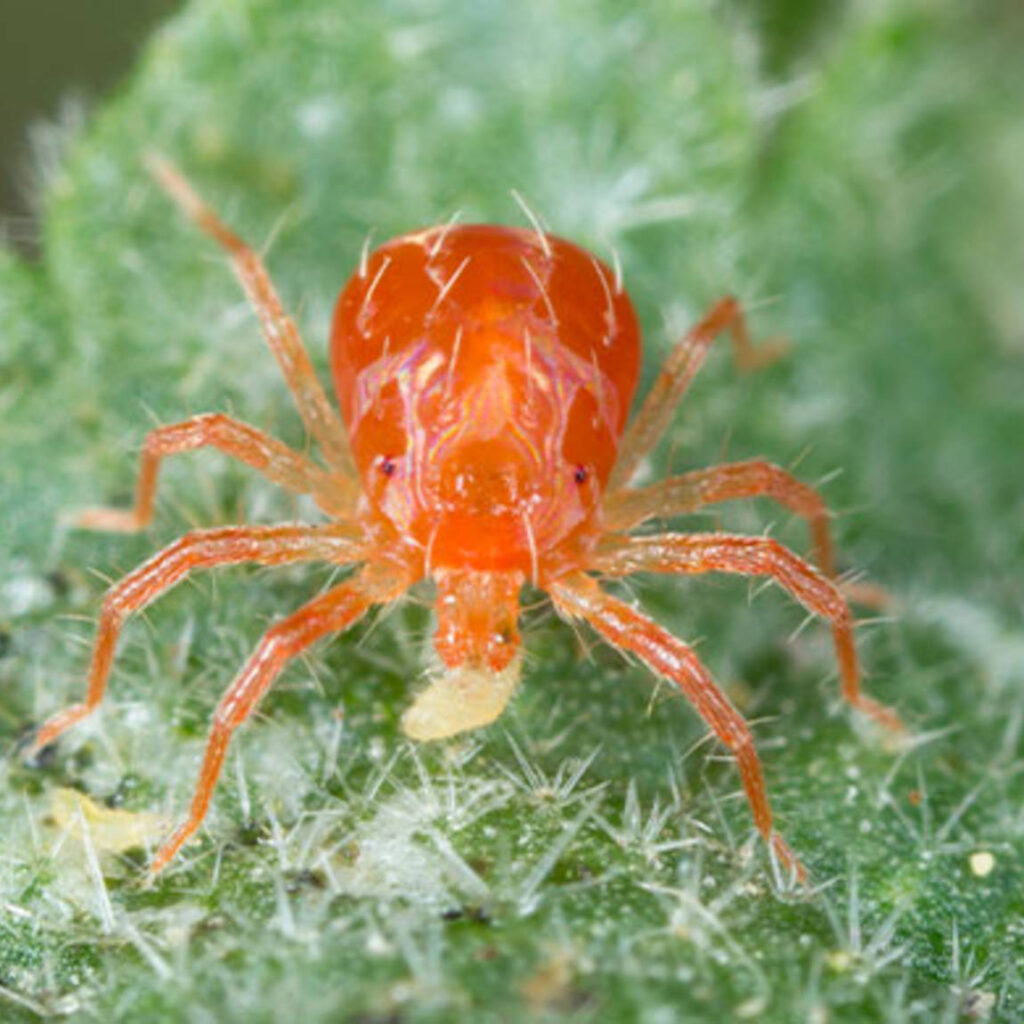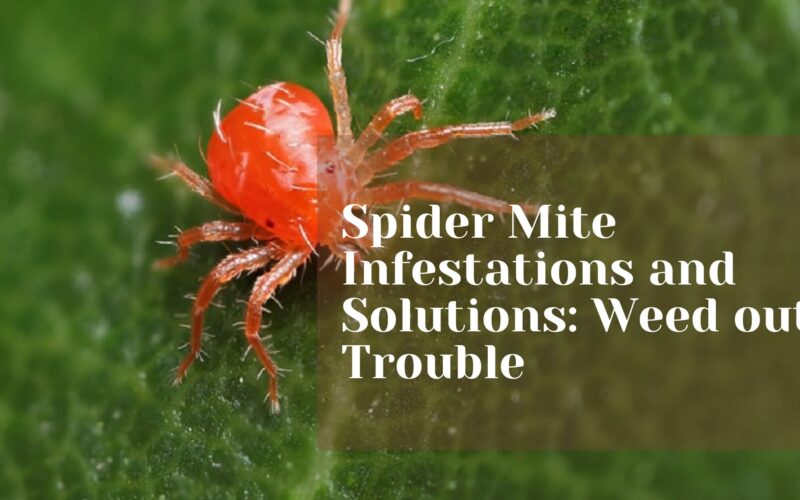Imagine your thriving garden or greenhouse being attacked by tiny, almost invisible arachnids—spider mites. These small pests, less than 1 mm or 0.04 inches long, are a significant threat to many plants.
They feed on plant sap and chlorophyll, causing damage that lowers yields and affects the overall health of your plants. Spider mites reproduce quickly and thrive in warm, dry environments, making them particularly challenging for gardeners and growers to control.
We’ll cover the best ways to prevent and treat them, including organic solutions and integrated pest management (IPM) methods. By the end, you’ll know how to fight spider infestations and find solutions to protect your plants effectively.
What Are Spider Mites?
Spider mites are tiny arachnids belonging to the Tetranychidae family. They belong to the Tetranychidae family and are less than 1 mm long. These pests can feed on a variety of plants, and understanding their life cycle and the signs of spider mite damage is crucial for effective control.

Spider Mite Life Cycle And Appearance
The life of a spider mite goes through four stages: egg, larva, nymph, and adult. This cycle can be completed in 2–3 weeks, causing their numbers to grow rapidly. Spider mites can be hard to see but come in various colors, like pale, red, or green.
Their eggs are tiny and hatch every three days, making them difficult to eradicate once they start infesting plants.One way to spot spider mites is by looking for their fine webs. These webs protect the mites and their eggs. To see the mites, you might need a magnifying glass or a microscope.
Signs Of Spider Mite Damage On Plants
Early signs of spider mite damage include small spots or discoloration on leaves. As the problem worsens, you’ll see more webs, usually under leaves and stems. Other signs include yellow or tan spots, leaf curls, and a plant that looks sunburned.
Regularly inspecting your plants, especially under leaves, is key to finding spider mites early. By understanding the spider mite life cycle and signs of spider mite damage, you can act quickly to save your plants.
Spider Mite Infestations: A Serious Threat to Plant Health
Spider mites are a big problem for many plant growers. They can quickly spread and multiply, making them hard to control. Their webs and eggs are tough to get rid of, especially when plants are flowering or fruiting. If not dealt with, spider mites can significantly reduce the yield, quality, and overall health of plants.
Spider mites are more like spiders than insects, with eight legs and no antennae. Adults are tiny, measuring just 1/50 of an inch, and their young are even smaller. The two-spotted mite is a common species that feeds on over 200 plant species, preferring dusty areas and drought conditions.
A single female spider mite can produce a million offspring in less than a month. They can quickly destroy young, tender plants. Spider mites cover plant leaves and buds with silk webs, making recovery difficult. It’s crucial to be vigilant and use a strong pest control plan to stop spider mite infestations.
Environmental Factors Favoring Spider Mite Infestations
Spider mites love certain conditions, and understanding these is key to stopping them. They thrive in warm, dry places with temperatures over 75°F (24°C). The warmer it gets, the quicker they grow, completing their life cycle in just a week.
They also prefer dry environments with a humidity level below 50%. Dry air makes them feed more and grow faster. However, watering plants during dry periods can slow their development.
Ideal Conditions For Spider Mite Reproduction
Spider mites can adapt and grow rapidly when conditions are favorable. Female mites can lay up to 12 eggs a day for several weeks, leading to exponential population growth.
Dirty conditions and stressed plants exacerbate the problem. The use of chemicals can also backfire by killing off natural predators or making plants more appealing to spider mites.
Understanding what spider mites prefer helps in fighting them. Maintaining the right temperature, humidity, and airflow and ensuring proper watering can help prevent spider mite infestations. These steps are crucial to keeping spider mites at bay.
Natural Prevention And Control Methods
Gardeners and growers have many natural ways to prevent and control spider mites. One effective method is using beneficial insects that prey on spider mites. Ladybugs, six-spotted thrips, and minute pirate bugs are excellent examples.
They can consume large numbers of spider mites, helping to keep their populations in check.These beneficial insects thrive in the same environments as spider mites, making them an effective choice for controlling these pests.

By introducing them into your growing area, you create a natural balance that helps keep spider mites from becoming a serious problem.
Using Beneficial Insects As Predators
Ladybugs are great at eating spider mites. They can consume hundreds of them in their lifetime, making them very useful for pest control. Six-spotted thrips and minute pirate bugs also prey on spider mites, helping to maintain plant health.
Cultural Control Practices
There are also cultural practices to help prevent spider mites. Keeping your growing area clean and inspecting your plants regularly are key. Additionally, ensuring your plants receive the proper nutrients, water, and environmental conditions can help make them less susceptible to spider mites.
Using beneficial insects and cultural practices together can help prevent spider mites and keep your plants healthy and strong.
Organic Miticides And Essential Oil Sprays
When natural methods are insufficient, organic miticides and essential oil sprays can help eliminate spider mites. Ingredients like rosemary oil, cinnamon oil, and Beauveria bassiana fungus can effectively control and eradicate these pests.
Application Guidelines For Organic Miticides
It’s essential to apply these organic solutions correctly. Spray the entire plant, including the underside of the leaves, for complete coverage. You should spray every 3–4 days to target newly hatched spider mite eggs.
For indoor use, wait 2-3 hours before turning on lights and fans. You can use it immediately without diluting it. There’s no waiting period to re-enter the area after spraying.Apply it every 3–5 days to treat infestations.
For prevention, spray every 7 days as needed. There’s no limit to how many times you can use it in a growing cycle.Other options, like neem oil and pyrethrins, can also fight spider mites. Use them at 3-day intervals until the problem is resolved.
Horticultural oils can be used to reduce spider mite eggs in overwintering sites.Remember, use miticides as a last resort during the flowering stage. Biological controls, like beneficial insects, are better for spider mite control.
Integrated Pest Management For Spider Mites
Managing spider mites on plants requires a comprehensive Integrated Pest Management (IPM) plan. This plan incorporates preventative measures, beneficial insects, and organic pesticides when necessary.
It considers plant health and the pest life cycle to provide long-term control of spider mites, ensuring the quality and yield of crops.
Preventative Cultural Practices
Preventing spider mites begins with good cultural practices that make their environment less hospitable. These include:
- Maintaining optimal temperature and humidity levels in the growing space
- Ensuring proper air circulation to discourage mite buildup
- Regularly inspecting plants for early signs of infestation
- Promptly removing and disposing of infested plant material
- Practicing good sanitation by regularly cleaning grow equipment and surfaces
Biological Control With Beneficial Insects
Using predatory mites and other beneficial insects is an effective way to manage spider mites. Some effective ones include:
- Persimilis mites: Highly effective against two-spotted spider mites, especially in cooler conditions
- Swirski mites: Well-suited for controlling spider mites during hot summer months
- Californicus mites: Versatile predators that thrive in a wide range of temperatures
These natural enemies can be released to target spider mite populations, reducing the need for chemical pesticides.
Organic Miticide Applications
For severe spider mite infestations, organic miticides might be necessary. Products like insecticidal soap and horticultural oils can kill mites. However, use these miticides carefully, as they can also harm beneficial insects.
By using a comprehensive IPM approach, gardeners and growers can effectively control spider mites, keeping their plants healthy and avoiding harmful synthetic pesticides.
This method, which combines cultural, biological, and organic controls, is key to managing spider mites in various plant settings.
Conclusion
Spider mites can be a significant problem for plant growers, reducing yields and the quality of crops. Understanding how spider mites live, spotting early signs of infestation, and implementing a comprehensive pest management plan can help control these pests.
Using natural prevention methods, such as maintaining optimal environmental conditions and introducing beneficial insects, can make it difficult for spider mites to thrive. Incorporating organic miticides and essential oil sprays can also help combat spider mites.
By combining these natural methods, growers can keep their plants safe and healthy.A robust pest control plan requires a proactive approach and the integration of multiple strategies.
This guide provides a detailed approach to managing spider mite infestations, ensuring your plants remain healthy and productive.
